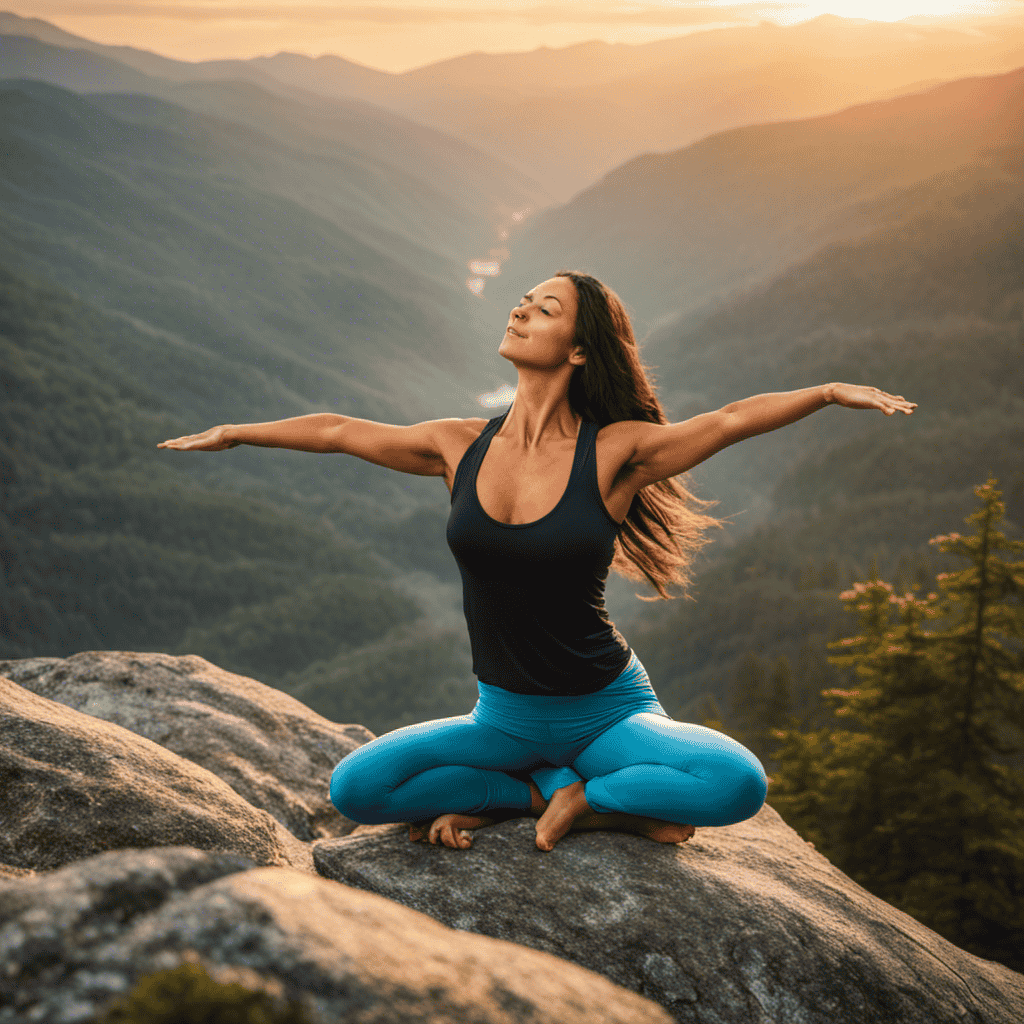As an experienced yogi, I’ve discovered that advanced yoga techniques can truly elevate your practice to new heights.
Did you know that only 8% of yoga practitioners venture beyond the basic poses and delve into the realm of advanced techniques?
In this article, I will guide you through a variety of powerful practices, including pranayama, advanced asanas, yoga nidra, and more.
Get ready to deepen your mind-body connection and unlock the transformative potential of advanced yoga.
Key Takeaways
- Progression is important in advanced asanas to build strength and flexibility.
- Basic variations of challenging poses should be practiced before attempting advanced variations.
- Balance poses like Tree Pose and Eagle Pose require physical strength and mental focus.
- Advanced inversions like Handstand and Forearm Stand require a strong core and upper body strength.
Pranayama Techniques
Pranayama techniques are essential for improving breath control and promoting relaxation during advanced yoga practice. Pranayama, which translates to ‘extension of breath,’ refers to various breathing exercises that have numerous benefits for the mind and body.
One of the primary benefits of pranayama is stress relief. When we feel stressed, our breath becomes shallow and rapid. By practicing pranayama techniques, we can learn to control our breath, slowing it down and deepening it. This triggers the relaxation response in our body, calming the nervous system and reducing stress levels.
There are several pranayama techniques specifically designed for stress relief. One such technique is called Nadi Shodhana, or alternate nostril breathing. This technique involves using the thumb and ring finger to alternate between closing one nostril and breathing through the other. It helps balance the energy in the body and relaxes the mind, making it an effective tool for stress management.
Another pranayama technique that promotes relaxation is the 4-7-8 breath. This technique involves inhaling for a count of four, holding the breath for a count of seven, and exhaling for a count of eight. It activates the body’s relaxation response and helps calm racing thoughts and anxiety.
Incorporating pranayama techniques into your advanced yoga practice can greatly enhance your breath control and promote deep relaxation. By regularly practicing these techniques, you can experience the profound benefits of pranayama for stress relief and overall well-being.
Advanced Asanas
When it comes to advanced asanas, one of the key aspects to focus on is the progression of challenging poses. It’s important to approach these poses with caution and gradually build up the necessary strength and flexibility to safely attempt them.
In this discussion, I will also be sharing some injury prevention tips to help you stay safe and avoid common pitfalls while practicing these advanced poses.
Challenging Poses Progression
To progress in challenging poses, you’ll need to gradually increase your strength and flexibility. Challenging balance poses like Tree Pose or Eagle Pose require not only physical strength but also mental focus and stability.
It’s important to start with the basic variations of these poses and gradually work your way up to more advanced variations. This will help you build the necessary strength and stability to hold these poses for longer durations.
Advanced inversions, such as Handstand or Forearm Stand, require a strong core and upper body strength. Incorporating exercises like Plank Pose and Dolphin Pose into your practice can help you build the necessary strength for these inversions.
Remember to always listen to your body and progress at your own pace to avoid injury.
Injury Prevention Tips
Injury prevention is crucial in any physical practice, so it’s important to warm up properly before attempting challenging poses. Yoga injury prevention is all about taking care of your body and being mindful of its limitations.
Here are some key tips to prevent common yoga injuries:
- Listen to your body: Pay attention to any discomfort or pain and modify or skip poses that don’t feel right.
- Engage your core: Strengthening your core muscles helps support your spine and prevent strain on other body parts.
- Use props: Props like blocks and straps can provide extra support and stability, especially if you’re new to a pose or recovering from an injury.
Yoga Nidra Practice
Yoga Nidra is a powerful practice that offers deep relaxation benefits. By following guided meditation steps, one can enter a state of profound relaxation and rejuvenation.
This practice also enhances mindfulness, allowing us to cultivate a deeper connection to the present moment and our inner selves.
Deep Relaxation Benefits
The deep relaxation benefits of yoga are numerous and can greatly improve overall well-being. Yoga Nidra, also known as yogic sleep, is a powerful practice that helps to induce deep relaxation and rejuvenation. Through this practice, one can experience a profound state of relaxation that goes beyond the ordinary relaxation techniques.
Here are some key benefits of yoga Nidra:
-
Enhanced self-awareness: Yoga Nidra allows you to explore your inner landscape, becoming more attuned to your thoughts, emotions, and sensations.
-
Reduced stress and anxiety: By calming the nervous system, yoga Nidra helps to alleviate stress and anxiety, promoting a sense of calm and tranquility.
-
Improved sleep quality: Regular practice of yoga Nidra can help you achieve better sleep, leading to increased energy and vitality throughout the day.
Guided Meditation Steps
To experience the benefits of guided meditation, you can start by finding a peaceful and comfortable space.
Guided meditation techniques involve following the instructions of a knowledgeable guide who will help you relax, focus, and find inner peace.
This practice has numerous benefits, including reducing stress, improving sleep quality, and enhancing overall well-being.
By allowing yourself to be guided through the meditation process, you can let go of distractions and immerse yourself fully in the present moment.
The guide’s soothing voice and gentle prompts can help calm your mind and bring about a sense of tranquility.
Through this practice, you can cultivate mindfulness, increase self-awareness, and develop a deeper connection with yourself.
Now, let’s explore how you can enhance your mindfulness through nidra, a powerful yoga technique.
Enhancing Mindfulness Through Nidra
After exploring the benefits of guided meditation, let’s delve into another powerful mindfulness practice: Nidra, also known as yogic sleep. Nidra involves deep relaxation techniques that promote a state of conscious awareness. It is a highly effective way to release tension, reduce stress, and enhance mindfulness.
To engage in Nidra, you can follow these mindfulness exercises:
- Find a comfortable position and close your eyes.
- Bring your attention to your breath, observing the inhales and exhales.
- Scan your body from head to toe, noticing any areas of tension or discomfort.
- Practice progressive muscle relaxation, consciously releasing tension from each part of your body.
- Visualize yourself in a peaceful, serene environment, immersing yourself in the sights, sounds, and sensations.
- Cultivate a sense of gratitude and compassion towards yourself and others.
- Gradually bring your awareness back to the present moment, gently opening your eyes.
Nidra allows you to experience deep relaxation while nurturing mindfulness, promoting overall well-being.
Bandha and Mudra Practices
Practicing bandha and mudra techniques can enhance your yoga practice. Bandha techniques involve the contraction and control of specific muscles in the body to enhance energy flow and deepen the practice.
There are three main bandhas: Mula Bandha, which engages the pelvic floor muscles; Uddiyana Bandha, which involves drawing the abdominal muscles in and up towards the spine; and Jalandhara Bandha, which is the throat lock. These techniques help to increase stability, strengthen the core, and improve focus during yoga poses.
On the other hand, mudras are hand gestures that have symbolic meanings and can also enhance your yoga practice. Mudras work by redirecting energy flow within the body and connecting different energy channels. They can be used in conjunction with asanas and pranayama to deepen concentration and promote specific energetic effects.
For example, the Jnana Mudra, where the thumb and index finger touch, is known to enhance wisdom and clarity of thought.
By incorporating bandha and mudra techniques into your yoga practice, you can experience a deeper connection between mind, body, and spirit. These techniques not only enhance the physical aspect of yoga but also promote mental and energetic balance.
Advanced Meditation Techniques
Using advanced meditation techniques can greatly enhance your overall mindfulness practice. These techniques require a deeper level of concentration and breath control, allowing you to delve into a state of profound awareness. Here are three powerful methods that can take your meditation practice to the next level:
-
Visualization: By visualizing a serene and tranquil environment, such as a peaceful beach or a lush forest, you can create a vivid mental image that helps calm the mind and deepen your focus. This technique allows you to detach from distractions and immerse yourself in the present moment.
-
Mantra repetition: Repeating a specific word or phrase, known as a mantra, can help to quiet the mind and cultivate a sense of inner stillness. Whether it’s a traditional Sanskrit mantra or a personal affirmation, the rhythmic repetition of the mantra can aid in maintaining concentration and promoting a deep state of relaxation.
-
Body scan: This technique involves systematically scanning your body from head to toe, paying close attention to any sensations or areas of tension. By bringing awareness to each part of your body, you can release physical and mental stress, allowing for a greater sense of relaxation and presence.
Energy Healing Through Yoga
The benefits of energy healing through yoga can be experienced by incorporating specific poses and breathwork into your practice. Yoga therapy is a powerful tool that combines physical postures, breathing exercises, and meditation to promote overall well-being and healing.
Through the use of energy healing methods, such as pranayama (breath control) and asanas (yoga poses), yoga therapy can help restore balance and harmony to the body, mind, and spirit.
One of the main benefits of yoga therapy is its ability to release blocked energy and promote the flow of prana, or life force, throughout the body. By practicing specific poses and breathwork, we can activate and balance our energy centers, known as chakras, which can help alleviate physical and emotional imbalances. This can lead to improved physical health, reduced stress and anxiety, increased mental clarity, and a greater sense of overall well-being.
Incorporating energy healing methods into your yoga practice can also help cultivate a deeper connection to yourself and the world around you. By focusing on the breath and engaging in mindful movement, you can become more present and aware of the subtle energy within and around you. This heightened awareness can lead to a greater sense of self-empowerment and a deeper understanding of your own energetic makeup.
Overall, the benefits of energy healing through yoga are numerous and profound. By incorporating specific poses and breathwork into your practice, you can experience improved physical, mental, and emotional well-being, as well as a deeper connection to yourself and the world around you.
Yoga for Chakra Activation
In my journey of exploring advanced yoga techniques, I have come across a powerful practice that focuses on chakra activation. Chakras are energy centers in the body that play a crucial role in our physical, mental, and emotional well-being. When these chakras are balanced and aligned, we experience a harmonious state of being.
Yoga for chakra activation involves specific postures, breathwork, and meditation techniques that help in balancing and awakening the chakras. This practice not only enhances our overall energy levels but also promotes self-awareness and spiritual growth.
To give you a glimpse into this transformative practice, here are three key aspects of yoga for chakra activation:
-
Asana: Practicing yoga poses that target specific chakras helps in opening and balancing those energy centers. For example, poses like Camel Pose (Ustrasana) activate the Heart Chakra, while Shoulder Stand (Sarvangasana) stimulates the Throat Chakra.
-
Pranayama: Breathwork plays a significant role in chakra activation. Techniques like Alternate Nostril Breathing (Nadi Shodhana) and Breath of Fire (Kapalabhati) help in purifying and energizing the chakras.
-
Meditation: Guided meditation practices focused on each chakra aid in deepening our connection with these energy centers. Visualizations, affirmations, and mantras are used to activate and balance the chakras.
Yoga for Mind-Body Alignment
Practicing yoga helps align the mind and body, leading to a state of overall well-being. The mind-body connection is a fundamental aspect of yoga, and through various poses, breathing exercises, and meditation techniques, this connection can be strengthened and cultivated. One of the main benefits of yoga is its ability to relieve stress and promote relaxation. When we are stressed, our minds and bodies can become disconnected, leading to a state of imbalance and tension. By engaging in yoga practices specifically designed to address stress relief, we can bring our mind and body back into harmony.
Here is a table showcasing three yoga poses that are particularly effective for stress relief:
| Pose | Benefits | How to Do It |
|---|---|---|
| Child’s Pose | Calms the mind and body, relieves tension in the back and neck | Start on your hands and knees, then sit back on your heels and lower your forehead to the mat while reaching your arms forward |
| Legs-Up-The-Wall | Relaxes the nervous system, reduces anxiety and fatigue | Lie on your back with your legs extended up against a wall |
| Corpse Pose | Promotes deep relaxation and rejuvenation | Lie flat on your back, arms at your sides, palms facing up, and legs extended straight |
Mantra and Sound Meditation
In my journey to explore advanced yoga techniques, I have come across a powerful practice called mantra and sound meditation. This practice involves the repetition of sacred sounds or phrases, known as mantras, to achieve deep states of relaxation and healing.
Mantra chanting has been used for centuries as a tool for spiritual awakening and inner transformation. The rhythmic repetition of these sacred sounds creates a resonance within our being, allowing us to connect with our true essence and tap into our inner wisdom.
Sound healing, on the other hand, utilizes various instruments and vibrations to balance and harmonize our energies. This can include using singing bowls, gongs, or even our own voices to produce soothing and healing sounds.
Here are three key aspects of mantra and sound meditation:
-
Vibrational Healing: The vibrations created by mantra chanting and sound healing penetrate deep into our cells, tissues, and energy centers, promoting healing and balance.
-
Mental Clarity: The repetitive nature of mantra chanting helps to quiet the mind and bring clarity and focus to our thoughts.
-
Emotional Release: Sound vibrations have the power to release stagnant emotions and trauma, allowing for deep emotional healing and release.
Through mantra and sound meditation, we can experience profound states of relaxation, rejuvenation, and spiritual growth. It is a powerful practice that can enhance our overall well-being and connect us to our inner essence.
Exploring Yoga Philosophy and Spirituality
Yoga’s spiritual significance is a key aspect of its practice, and understanding the philosophy behind it can deepen one’s experience on the mat.
The ancient teachings of yoga offer a wealth of wisdom and guidance that can be applied to our modern lives.
From the concept of unity and interconnectedness to the pursuit of self-realization, exploring yoga philosophy can provide a framework for personal growth and spiritual exploration.
Yoga’s Spiritual Significance
The spiritual significance of yoga lies in its ability to connect the mind, body, and soul. Through the practice of yoga, we can experience profound transformations in our mental health and personal growth.
Yoga and Mental Health: Yoga helps to alleviate stress, anxiety, and depression by calming the mind, reducing cortisol levels, and promoting the release of endorphins. It provides a safe space for introspection and self-reflection, allowing us to cultivate mindfulness and find inner peace.
Yoga and Personal Growth: Yoga encourages self-awareness and self-acceptance, enabling us to develop a deeper understanding of ourselves and our emotions. It challenges us to step outside our comfort zones and embrace growth and change. With regular practice, we can enhance our physical strength, flexibility, and balance, which in turn boosts our confidence and self-esteem.
Philosophy in Yoga Practice
By exploring the philosophy in yoga practice, practitioners can gain a deeper understanding of themselves and their connection to the world around them. Yoga philosophy goes beyond the physical postures and dives into the underlying principles that guide the practice. Understanding these yogic principles can help individuals navigate their lives with more clarity and purpose.
To demonstrate the significance of yoga philosophy, let’s explore three key principles:
| Principle | Description | Application |
|---|---|---|
| Ahimsa | Non-violence towards oneself and others | Practicing compassion and kindness |
| Satya | Truthfulness | Speaking and living authentically |
| Santosha | Contentment | Cultivating gratitude and acceptance |
Frequently Asked Questions
How Can I Modify the Advanced Asanas to Accommodate Injuries or Physical Limitations?
When it comes to modifying advanced asanas to accommodate injuries or physical limitations, it’s important to listen to your body and make necessary adaptations.
By understanding your limitations and working with a qualified yoga instructor, you can find alternative poses or variations that suit your needs.
This may involve using props, adjusting alignment, or focusing on specific muscle groups.
Are There Any Precautions or Contraindications to Keep in Mind While Practicing Advanced Pranayama Techniques?
When practicing advanced pranayama techniques, it is important to be aware of any precautions or contraindications. It is crucial to listen to your body and not push yourself beyond your limits.
If you have any pre-existing medical conditions or respiratory issues, it is advisable to consult with a healthcare professional before attempting advanced pranayama.
Additionally, it is important to practice under the guidance of an experienced yoga teacher who can provide proper instructions and ensure your safety.
Can Yoga Nidra Practice Be Used as a Form of Therapy for Mental Health Disorders?
Yoga nidra therapy can indeed be used as a form of therapy for mental health disorders. It offers numerous benefits such as reducing stress, anxiety, and depression.
By practicing yoga nidra, one can experience deep relaxation and tap into the subconscious mind to address underlying emotional issues. It can also improve sleep quality and enhance overall well-being.
Incorporating yoga nidra into a therapeutic approach can be highly effective in promoting mental health and healing.
What Are the Benefits of Incorporating Bandhas and Mudras Into an Advanced Yoga Practice?
Incorporating bandhas and mudras into a yoga practice can offer numerous benefits.
Bandhas are energy locks that help to direct and control the flow of prana, or life force energy, within the body. They can enhance stability, strength, and focus during asanas.
Mudras, on the other hand, are hand gestures that stimulate different parts of the brain and promote healing and balance.
How Can I Deepen My Meditation Practice Through the Use of Advanced Meditation Techniques?
To deepen my meditation practice, I can explore advanced meditation techniques. These techniques focus on deepening concentration and exploring mindfulness. By incorporating these techniques into my daily practice, I can enhance my ability to stay present and cultivate a deeper sense of awareness.
Some advanced techniques that I can try include breathwork, visualization, mantra repetition, and body scanning. These techniques can help me develop a more profound and transformative meditation experience.
Regularly practicing these advanced techniques will allow me to deepen my meditation practice even further. It will help me unlock new levels of focus, mindfulness, and self-awareness.
Conclusion
In conclusion, advanced yoga techniques offer a deeper level of practice and understanding for those seeking to elevate their yoga journey. By incorporating pranayama techniques, advanced asanas, and yoga nidra practice, individuals can explore new dimensions of relaxation and self-awareness.
Additionally, the use of bandha and mudra practices, advanced meditation techniques, and yoga for chakra activation can help in achieving a balanced mind-body connection. It is fascinating to note that a study conducted by the National Center for Complementary and Integrative Health found that regular yoga practice can alleviate symptoms of chronic pain in individuals.
With these advanced techniques, one can truly unlock the full potential of yoga and experience its profound benefits on both the physical and spiritual levels.




